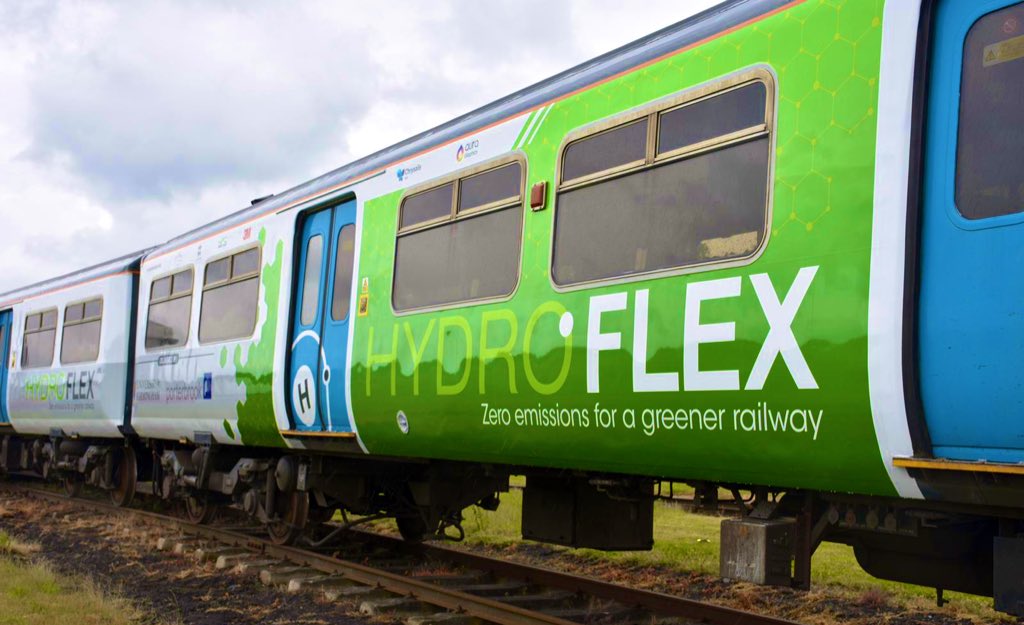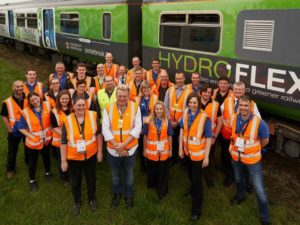Dr Stuart Hillmansen, Senior Lecturer in Electrical Energy Systems, tells us about how to replace diesel using Hydrogen and battery power
The centre’s research has shown the best current candidate to provide traction power to replace diesel multiple units is a combination of hydrogen fuel cell and battery. Each of the sub-systems involved in creating our HydroFLEX train depends on the huge advances in recent decades in our understanding of material science.
The fuel cell used in the HydroFLEX project is provided by Ballard and can provide an output power of 100 kW. The fuel cell is a device which uses hydrogen as a fuel, which is combined with oxygen present in the atmosphere to generate electricity through an electrochemical reaction. The hydrogen gas is kept separated from the oxygen using a membrane. This membrane is coated with a platinum catalyst which enables the hydrogen molecules to split into H+ ions and electrons. On the other side of the membrane, the oxygen molecules also undergo a catalytic reaction and form negatively charged oxygen ions. There is therefore a strong attraction between the positive H+ ions and the negative O- ions across the membrane. The membrane allows the H+ ions to pass through and combine with the oxygen ions and electrons creating water. The electrons, which were produced on the anode also need to get to this side of the membrane and they are conducted from the anode through an external circuit before arriving at the cathode to form the water. The membrane itself is a highly complex piece of materials engineering which draws upon decades of material science research.
A fuel cell creates electricity directly, and there is no combustion, and therefore fuel cells can achieve a high efficiency. They also are quiet in operation, and are low maintenance. However perhaps the most significant reason for using a hydrogen fuel cell, is that the hydrogen can in theory be produced from renewable electricity, and can be completely decoupled from fossil fuels.

The research team at BCRRE have familiarity with a number of fuel cells and their operation. From a systems view, it is possible to treat the fuel cell as a ‘black box’ and run it properly using the known system characteristics. The fuel cell typically has a number of key interfaces. Foremost is the hydrogen supply point, which takes 8.5 Barg gas from the high pressure storage via a gas regulator. Then there is the electrical power output connection, and the air intake which uses the Oxygen in the atmosphere to combine with the Hydrogen to produce the electrical energy. The fuel cell, whilst highly efficient, does produce unwanted heat which needs to be removed through a cooling system. This heat can be used for saloon heating in colder months so strictly is not always waste heat. Finally there will be some control and communications interface which will be connected to the vehicle system.

Read about the original Hydrogen train, Hydrogen Hero, here https://www.birmingham.ac.uk/news/latest/2018/06/uk-first-operational-hydrogen-train-unveiled.aspx
Read about starting off the project here: https://www.birmingham.ac.uk/news/latest/2018/09/joint-initiative-to-develop-hydroflex-the-uks-first-hydrogen-train.aspx
And about HydroFLEX’s next challenge – mainline testing: https://www.birmingham.ac.uk/news/latest/2019/06/mainline-testing-of-uk-first-hydrogen-train.aspx
